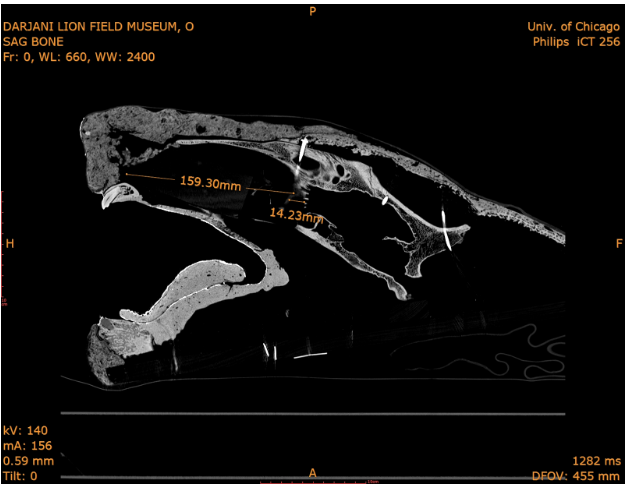- African lions do not usually feed on porcupines. However, in the absence of preferred prey like wildebeests, zebras and other ungulates, they can turn to the prickly rodents.
- Many of these encounters, according to a new study that documented 50 of them, don’t end well for the lions, which can be wounded or die from the quills.
- A lion wounded in a porcupine encounter, and thus impaired from hunting and feeding, may turn to hunting softer targets such as humans and cattle.
- The choice of porcupine as food also suggests the absence of other prey which may also lead a lion to prey on humans.
For those who relish a meaty David vs. Goliath story, the contest between a porcupine and a mighty African lion is a must-watch. Male African lions (Panthera leo) are about 10 times heavier than a crested porcupine (Hystrix cristata), but even for the king of the jungle feeding on these spiky stout rodents is more minefield than cakewalk.
The main obstacles, of course, are the quills. As a porcupine attempts to get a lion off its back, the quills can pierce a lion’s face, mouth or paws. A study published in the Journal of East African Natural History this week finds that this interaction could hold lessons about man-eating lions.
The team documented 50 incidents of lions being injured or even dying in porcupine encounters between 1960 and May 2016, and examined the skulls of three lions involved in them to learn more about their dietary habits.

Why would lions get entangled with this prickly prey? Their diet usually consists of wildebeests, zebras and other ungulates. “We predict that lions turn to porcupines only when, for a variety of reasons, those more preferred prey items are not otherwise available including poaching, drought, disease that afflict prey species preferred and depended upon by lion,” lead author Julian Kerbis Peterhans, a researcher at the Field Museum, Chicago, and professor at the city’s Roosevelt University, told Mongabay by email.
The numbers of African lions fell by 42 percent between 1993 and 2014, according to the International Union for Conservation of Nature. Habitat loss and depleting stocks of prey are major factors in their decline. Unpredictable rainfall and failure of rains that impact prey populations also trigger this behavior. “Lions that lived on harsher, drier terrain seemed to rely more on porcupines for food, at least periodically, perhaps because other prey weren’t available,” the authors said.
The link between eating porcupines and eating humans, however, isn’t straightforward.
A badly executed porcupine attack can cause injury to the lion, hampering its hunting abilities. But its willingness to hunt porcupine suggests that other prey is scarce in the first place. Both conditions could push the big cat toward easier prey, like humans and cattle.
While most man-eating big cats are usually thought of as aged predators past their prime, the study threw up another interesting phenomenon, which the researchers are calling the “young foolish male syndrome.” It appears that younger lions are more likely to go after porcupines, and most of those hurt by porcupines were male.
The break from the narrative of old lion preys on humans prompted the authors to dig deeper into the factors that lead to man-eating among these lions. They went back more than a century to examine the infamous series of attacks in the 1890s when two male lions struck terror in the hearts of laborers who were part of a colonial railway building project in the Tsavo region of what was then British East Africa (today Kenya). Both were hunted down in the winter of 1898.
Thomas Patrick Gnoske at the Field Museum, a co-author of the new paper, located the skulls of the two lions, which are a part of the museum’s collection. To deduce their life histories and dietary preferences required some sleuthing around the skulls, and CT scans. Both lions had fragments of porcupine quills nestled in their broken teeth, leading the researchers to believe that their porcupine- eating habits may have impaired their ability to hunt.

But the most striking case of death precipitated by porcupine quill came from the skull of the “Darajani Maneater,” which reigned in the 1960s in the Tsavo region. A 23-centimeter (9-inch) quill was lodged in its nose, penetrating more than 12 centimeters (5 inches) deep, which would have hindered its ability to hunt and eat. The starving man-eater was later killed by two hunters.
While protection of their habitat and ensuring that food supplies do not collapse is one way of protecting the lions, there seems to be no sure-shot way of keeping them off porcupines. In light of this, the authors of the paper recommend that tourists and locals report a wounded lion to the authorities if they spot one, to keep the big cat and humans from meeting a sticky or bristly end.
Citations:
Peterhans, J. C. (2019). Lion-Porcupine Interactions in Africa, Including Impacts on Lion Predatory Behavior. Journal of East African Natural History,108(1), 1. doi:10.2982/028.108.0101
Peterhans, J. C., & Gnoske, T. P. (2001). The Science of ‘Man-Eating*’ Among Lions Panthera leo With a Reconstruction of the Natural History of the ‘Man-Eaters of Tsavo’. Journal of East African Natural History,90(1), 1. doi:10.2982/0012-8317(2001)90[1:tsomal]2.0.co;2
Banner Image: A 1965 photograph of a deceased lion that, due to a porcupine injury, resorted to killing humans. The white tip of the porcupine quill is visible sticking out of the lion’s nostril. Image Courtesy: Julian Kerbis Peterhans, photo by John Perrott.
Malavika Vyawahare is the Madagascar staff writer for Mongabay. Find her on Twitter: @MalavikaVy
FEEDBACK: Use this form to send a message to the author of this post. If you want to post a public comment, you can do that at the bottom of the page.
